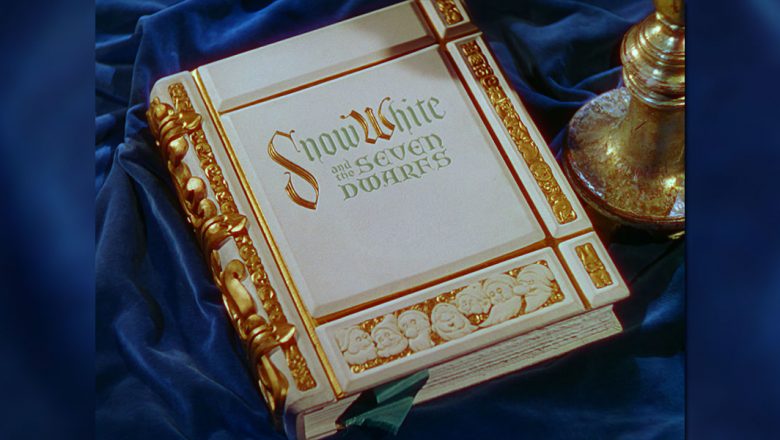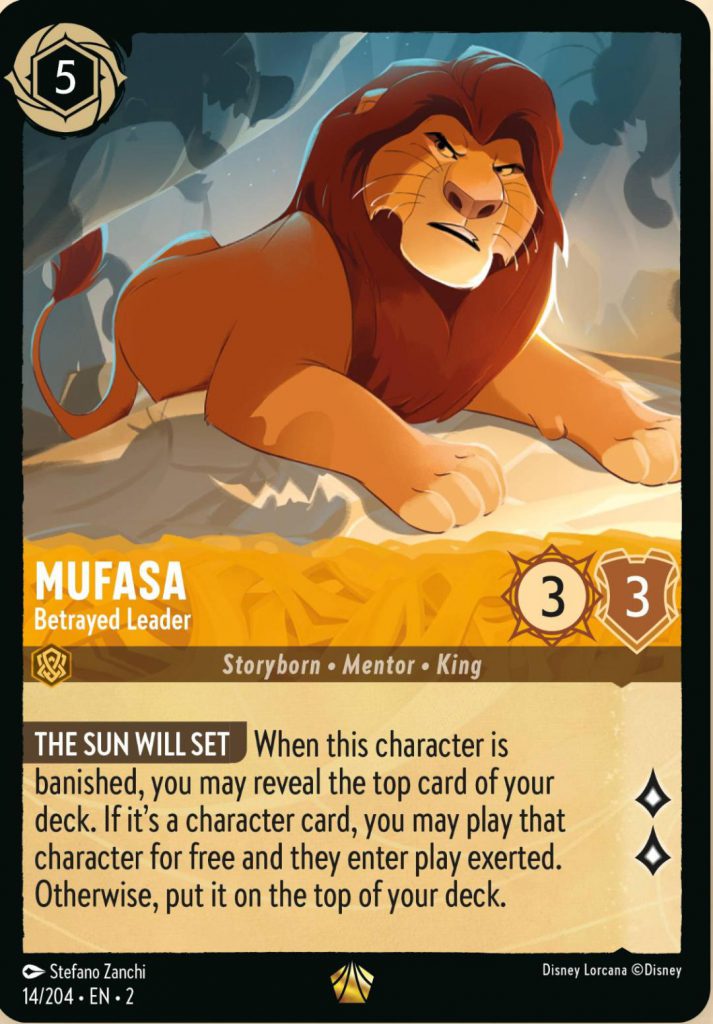In my days of writing about board games, it was always important to me to express that games can be a powerful tool for creating narrative experiences. It can be magical to watch mechanisms, game states, context, interaction, and player decisions weave together in such a way to support emergent storytelling. I think that it is particularly important that Lorcana succeeds in this regard because Disney at their best are all about storytelling through characters, visuals, colors, sounds, moods, atmospheres, and environments. And I’ve been quite impressed at how the game has the capability to create diegetic narrative through its card design. The game’s official lore is kind of doofy and frankly not all that interesting, but within the cards lie some lovely storytelling moments.

Of course, diegetic narrative isn’t unprecedented in the TCG format- there are plenty of examples throughout Magic: The Gathering of how mechanical design triangulates with card titles, conceptual effects, and artwork to tell micro-stories or to illustrate the broader lore of the game. And there have been games such as the long-lost Lovecraft-based Mythos and the Middle-Earth Collectible Card Game have sought to tell very specific stories and sometimes quite detailed stories.
One of the broader ways in which Lorcana accomplishes its narrative is by distinguishing between Storyborn, Dreamborn, and Floodborn characters. Not only does this open the game up to having multiple versions or iterations of each classic Disney princess for example, it also illuminates the key story concept of the game- that these “glimmers” exist in the form that we know them from their origin stories, the idealized selves of their dreams, and their Shifted Floodborn variants that represent Cinderella as a knight, Jafar as a mecha cobra, or Lady Tremaine as a sort of vampire queen. In gameplay, Floodborn characters can be played for a discount on top of existing characters of the same name, illustrating the in-lore catastrophe that results in these evolutions.
Singing is another example of narrative development. Songs are action cards that can be played for free by exerting an applicable character, based on their ink cost. Of course we all know and love the Disney songs and it’s virtually impossible to play this game without getting “One Step Ahead” or “Friends on the Other Side” stuck in your head- and this creates a theater-of-the-mind musical setting for the gameplay as well as a very Disney vibe throughout. And it’s fun, in the context of this alternate mix-up Disney world to have Kuzco sing “Let it Go”. It creates a story of connectivity across these characters and films beyond the brand name.

But most interesting to me are the subtle ways that card effects are used to express story moments, both for individual cards and within synergies between them. There’s no better example than the Storyborn Mufasa, Betrayed Leader. The art captures Mufasa’s final moments from the Lion King while his ability, The Sun Will Set tells the story. When Mufasa is banished you look scry top card on your deck. If it’s a character, you play it for free, exerted. So it could be that the storyline (and bloodline) of The Lion King continues if you draw any of the Simba cards, or it could be that you pull someone else and the story branches off, continuing with them. Either way, the character comes into play exerted because abstractly it represents the theme of grieving. Which of course, makes no sense if you draw Scar, in which case, you might say he’s too busy gloating. But what kind of monster runs both Scar and Mufasa in the same deck?
The game is packed with little details like this, sometimes pointing across the table to other cards. Cruella De Vil, Fashionable Cruiser has “Now Get Going” which gives her Evasive during the player’s turn. Why? So they can run over Pongo, who can only be challenged by a character with Evasive. The Floodborn Beast, Tragic Hero is glum but generous, issuing you an extra card every draw phase. But if he takes damage, he stops being kind and turn into a 7/5 murder machine. Mother Gothel, Selfish Manipulator prevents your opponent’s characters from questing- abstractly locking them up in a tower. The Three Musketeers’ abilities capture the “all for one, one for all” spirit between those versions of Mickey, Donald, and Goofy. And then there are very specific moments like how Le Fou is discounted if you have Gaston in play or the entire suite of mutually beneficial Seven Dwarves and how Snow White interacts with them.
All of these story beats are part of what make this game so delightful, particularly if you love Disney characters and stories. The detailing moves the design away from standard levels of abstraction and toward something that is more narrative, which is wholly appropriate to the subject matter. I love that it sometimes hits the notes just right, but sometimes offers some fun “what if” scenarios and unexpected combinations of elements
It’s also an area I’d like to see the design explore- the notion of creating cohesive, story-driven spaces between the cards. Perhaps with Saga-like cards that evolve and transform over the course of play. Lots of Lorcana players are asking the question, “can I make a deck based on a specific film” and right now the answer to that is “not really” but I can imagine future starter or theme decks leaning into the narrative aspects and doing something like an all-Frozen or all Big Hero 6 thing. With Into the Inklands bringing locations into the mix, these kinds of decks may very well be a thing soon.

Circling back to the game’s official storyline, I did like how there were hints in the First Chapter of a larger story but they were (and still kind of are) vague. Like, why is Duke of Weselton looking at a strange purple intestine. Ravensburger has produced some frankly pretty bad animated shorts to detail this story of Illumineers illuminating in the Illuminarium or whatever it is and god help us I’m sure the idea of novels, comics, films, or other transmedia have been kicked around. But really, all of that including the meta-stories Lorcana tells through gameplay are second to the classic tales told by the films themselves.
Next time – The Top 10 cards of The First Chapter- Fight!
Have any questions or feedback? Drop us a note in the comments below or email us at contact@goonhammer.com.



You must be logged in to post a comment.